Claris FileMaker Pro 11 User guide
- Category
- Software manuals
- Type
- User guide
This manual is also suitable for

FileMaker
®
11
ODBC and JDBC Guide

© 2004–2010 FileMaker, Inc. All Rights Reserved.
FileMaker, Inc.
5201 Patrick Henry Drive
Santa Clara, California 95054
FileMaker is a trademark of FileMaker, Inc. registered in the U.S. and other countries. The file folder logo is a trademark of FileMaker,
Inc. All other trademarks are the property of their respective owners.
FileMaker documentation is copyrighted. You are not authorized to make additional copies or distribute this documentation without
written permission from FileMaker. You may use this documentation solely with a valid licensed copy of FileMaker software.
All persons, companies, email addresses, and URLs listed in the examples are purely fictitious and any resemblance to existing persons,
companies, email addresses, or URLs is purely coincidental. Credits are listed in the Acknowledgements documents provided with this
software. Mention of third-party products and URLs is for informational purposes only and constitutes neither an endorsement nor a
recommendation. FileMaker, Inc. assumes no responsibility with regard to the performance of these products.
For more information, visit our website at www.filemaker.com.
Edition: 01

Contents
Chapter 1
Introduction
About this guide 7
About ODBC and JDBC 7
Using FileMaker software as an ODBC client application 8
Importing ODBC data 8
Adding ODBC tables to the relationships graph 8
Using a FileMaker database as a data source 9
Accessing a hosted FileMaker Pro database 9
Limitations with third-party tools 10
Networking requirements 10
Updating files from previous versions 10
Installing current drivers 10
Chapter 2
Accessing external SQL data sources
Importing ODBC data 11
Executing SQL to interact with data sources via ODBC 12
Working with ODBC tables in the relationships graph 12
Data sources supported in FileMaker 11 13
Adding ODBC tables to the relationships graph 13
Chapter 3
Installing FileMaker ODBC client drivers
Hardware and software requirements 15
ODBC client driver requirements (Windows) 15
ODBC client driver requirements (Mac OS) 15
Networking requirements 15
ODBC client driver installation (Windows) 15
Configuring client drivers (Windows) 16
ODBC client driver installation (Mac OS) 17
Configuring client drivers (Mac OS) 18
Where to go from here 19

4 FileMaker ODBC and JDBC Guide
Chapter 4
Using ODBC to share FileMaker data
About ODBC 21
Using the ODBC client driver 22
Overview of accessing a FileMaker database file 22
Accessing a FileMaker database file from a Windows application 23
Specifying ODBC client driver properties for a FileMaker DSN (Windows) 23
Verifying access via ODBC (Windows) 24
Accessing a FileMaker database file from a Mac OS application 25
Specifying ODBC client driver properties for a FileMaker DSN (Mac OS) 25
Verifying access via ODBC (Mac OS) 26
Chapter 5
Installing FileMaker JDBC client drivers
Software requirements 27
Networking requirements 27
JDBC client driver installation 27
Using the JDBC client driver 28
Chapter 6
Using JDBC to share FileMaker data
About JDBC 29
Using the JDBC client driver 29
About the JDBC client driver 29
Using a JDBC URL to connect to your database 30
Specifying driver properties in the URL subname 31
Solutions with multiple FileMaker database files 32
Verifying access via JDBC 32

|
Contents 5
Chapter 7
Supported standards
Support for Unicode characters 35
SQL statements 35
SELECT statement 35
SQL clauses 36
FROM clause 37
WHERE clause 37
GROUP BY clause 38
HAVING clause 38
UNION operator 38
ORDER BY clause 39
FOR UPDATE clause 39
DELETE statement 42
INSERT statement 42
UPDATE statement 43
CREATE TABLE statement 44
ALTER TABLE statement 44
CREATE INDEX statement 45
DROP INDEX statement 45
SQL aggregate functions 46
SQL expressions 46
Field names 47
Constants 47
Exponential/scientific notation 48
Numeric operators 48
Character operators 48
Date operators 48
Relational operators 49
Logical operators 50
Functions 50
Functions that return character strings 51
Functions that return numbers 53
Functions that return dates 54
Operator precedence 54
ODBC Catalog functions 55
JDBC Meta Data functions 55
Reserved SQL keywords 55

Chapter 1
Introduction
This guide describes how you can use FileMaker
®
software as an ODBC client application and as a
data
source for ODBC and JDBC applications.
The following table gives an overview of how to use ODBC and JDBC with FileMaker software.
About this guide
1 For information on using ODBC and JDBC with previous versions of FileMaker Pro, see
www.filemaker.com/documentation.
1 This guide assumes that you are familiar with the basics of using ODBC and JDBC, and constructing
SQL queries. Refer to a third-party book for more information on these topics.
1 This guide uses “FileMaker Pro” to refer to both FileMaker Pro and FileMaker Pro Advanced, unless
describing specific FileMaker Pro Advanced features.
Note You can download PDFs of FileMaker documentation from www.filemaker.com/documentation.
Any updates to this document are also available from the website.
About ODBC and JDBC
ODBC and JDBC are application programming interfaces (APIs). ODBC is an API for applications written
in the C language, and JDBC is a similar API for the Java language. These APIs give client applications a
common language for interacting with a variety of data sources and database services, including
FileMaker
Pro and FileMaker Server Advanced.
All applications that support ODBC and JDBC recognize a basic subset of SQL (Structured Query
Language) statements. Working with SQL, you can use other applications (such as spreadsheets, word
processors, and reporting tools) to view, analyze, and modify data.
What do you want to do? How do you do it? Product See
1 Use FileMaker software as an
ODBC client application.
1 Access ODBC data stored in
an external SQL data source.
1. Interactively via the relationships graph
2. One-time, static via ODBC import or
File menu > Open. Also, the Import
Records script step and the Execute SQL
script step
1 FileMaker Pro
1 FileMaker Pro Advanced
1 FileMaker Server
1 FileMaker Server Advanced
1 This guide,
chapter 2.
1 FileMaker
Pro Help
1 Use a FileMaker database as a
data source.
1 Share FileMaker Pro data with
a third-party ODBC client
application.
1. SQL queries
2. ODBC and JDBC
1 FileMaker Pro
1 FileMaker Pro Advanced
1 FileMaker Server Advanced
only
This guide,
chapters 3 to 8.

8 FileMaker ODBC and JDBC Guide
Using ODBC or JDBC APIs, a client application communicates with a driver manager that identifies the
client driver to communicate with a data source.
FileMaker software can act either as a client application or as a data source.
Using FileMaker software as an ODBC client application
As an ODBC client application, FileMaker software can access data in external SQL data sources.
FileMaker software connects to the external SQL data source using the client driver for the ODBC data
source, and either imports ODBC data or works with ODBC tables in the relationships graph.
Importing ODBC data
You can import ODBC data in either of these ways:
1 from the File menu, by specifying an ODBC data source and entering SQL statements in the
FileMaker
Pro SQL Query builder dialog box
1 by creating a FileMaker script that uses the Import Records script step or the Execute SQL script step
For either of these methods, you enter the SQL statements yourself, so you need to know the supported SQL
statements and their syntax for your ODBC data source. Because you write the SQL statements yourself,
you can import ODBC data from any ODBC data source.
Adding ODBC tables to the relationships graph
When you add an ODBC table to the relationships graph, you can connect to and work with data in external
SQL data sources in much the same way that you work with data in the current, active FileMaker database
file. For example, you can:
1 create tables in the relationships graph for ODBC data sources
1 add supplemental fields to ODBC tables to perform unstored calculations or to summarize data in the
ODBC tables
1 add, change, and delete external data interactively
1 create relationships between fields in FileMaker tables and fields (also called “columns”) in ODBC tables
Because FileMaker Pro generates the SQL statements used to communicate with an ODBC table that has
been added to the relationships graph, you are limited to the specific Oracle, SQL Server, and MySQL data
sources that FileMaker Pro supports in the relationships graph.
Note You cannot modify the schema of external ODBC data sources using FileMaker Pro.
Chapter 2, “Accessing external SQL data sources,” describes how to use FileMaker software as an ODBC
client application.
Driver
Manager
Client
Application
Client
Driver
Client
Driver

Chapter 1
|
Introduction 9
Using a FileMaker database as a data source
As a data source, FileMaker data is shared with ODBC- and JDBC-compliant applications. The application
connects to the FileMaker data source using the FileMaker client driver, constructs and executes the SQL
queries using ODBC or JDBC, and processes the data retrieved from the FileMaker database solution.
Accessing a hosted FileMaker Pro database
With either FileMaker Server Advanced or FileMaker Pro, you can host a FileMaker database file as a data
source, sharing your data with other applications using ODBC and JDBC. The following table describes
what each FileMaker product allows.
If your FileMaker database solution uses more than one FileMaker database file, all of the database files
must be on the same computer.
The ODBC and JDBC plug-in components you need for sharing your data with other applications are
installed with FileMaker
Server Advanced and FileMaker Pro.
To access a hosted FileMaker database file, you need to install the corresponding ODBC or JDBC client
driver. Install the client driver on the machine where the third-party application is installed.
This guide documents how the ODBC and JDBC client drivers, when used with FileMaker Pro and
FileMaker
Server Advanced, support the industry standards for ODBC (Open Database Connectivity),
JDBC (Java Database Connectivity), and SQL (Structured Query Language).
1 Chapter 3, “Installing FileMaker ODBC client drivers,” explains how to install the driver files needed for
accessing a FileMaker data source using ODBC.
1 Chapter 4, “Using ODBC to share FileMaker data,” describes how to use the FileMaker ODBC client
driver to connect to a FileMaker data source from another application.
1 Chapter 5, “Installing FileMaker JDBC client drivers,” explains how to install the driver files needed for
accessing a FileMaker data source using JDBC.
1 Chapter 6, “Using JDBC to share FileMaker data,” describes how to use the FileMaker JDBC client
driver with a Java application or applet that connects to a FileMaker data source.
1 Chapter 7, “Supported standards,” describes the SQL statements that the ODBC and JDBC client drivers
support when used with FileMaker Pro and FileMaker Server Advanced.
Important If you disable ODBC/JDBC sharing after it has already been on, a data source hosted by
FileMaker
Server Advanced or FileMaker Pro immediately becomes unavailable. The database
administrator doesn’t have the capability to alert ODBC and JDBC client applications about the data
source’s availability (the administrator can communicate only with FileMaker database file clients). No
errors are reported, and the client application should notify users that the data source is not available and
transactions cannot be completed. If a client application attempts to connect to an unavailable FileMaker
database file, a message explains that the connection failed.
This FileMaker product Allows
FileMaker Server Advanced
Up to 50 connections and supports local access (same computer) and remote access (both for
middleware such as web servers, and for remote client access from desktop productivity applications).
FileMaker Pro Up to nine connections and supports local access (same computer) only.

10 FileMaker ODBC and JDBC Guide
Limitations with third-party tools
Microsoft Access: When using Microsoft Access to view data in a FileMaker data source, do not use data
from a summary field. The summary field’s data should not be edited in Microsoft Access, and the data value
that is displayed in Microsoft Access may not be accurate.
Networking requirements
You need a TCP/IP network when using FileMaker Server Advanced to host a FileMaker database file as a
data source over a network. FileMaker
Pro supports local access (same computer) only.
Updating files from previous versions
Installing current drivers
If you installed a driver from prior versions of FileMaker Pro or FileMaker Server Advanced, you must
install the driver for version 11.
The driver for FileMaker version 11 is not compatible with earlier versions of FileMaker Pro or FileMaker
Server Advanced.
For more information on installing drivers, see chapter 3, “Installing FileMaker ODBC client drivers” and
chapter 5, “Installing FileMaker JDBC client drivers.”
Note You have to create a Data Source Name (DSN) for each FileMaker database file you want to access
as a data source. If you have previously set up access through one DSN that allows tables to be spread among
several FileMaker database files, you’ll need to consolidate those tables into a single database file (or create
several DSNs).

Chapter 2
Accessing external SQL data sources
As an ODBC client application, FileMaker software can access data in external SQL data sources.
FileMaker software connects to the external SQL data source using the client driver for the ODBC data
source, and either imports ODBC data or works with ODBC tables in the relationships graph.
Whether you are importing ODBC data or working with ODBC tables in the relationships graph, you must
configure a driver for the ODBC data source you’re using. For example, to access records from an Oracle
database, you configure an Oracle client driver.
Importing ODBC data
When you import ODBC data, you need an ODBC client driver for the external SQL data source configured
on the client machine.
After configuring an ODBC client driver, you can interact with records, import records into an existing
FileMaker Pro database file, or create a new FileMaker Pro database file from an ODBC data source (such
as Oracle or Microsoft Access databases).
First, you access the data source you want to import from. Then you construct a query for the records you
want to import from the data source. Finally, if you’re importing data into an existing file, you map fields
from your data source to fields in your FileMaker Pro database file.
You can access your ODBC data source through the File menu, with the Import Records script step, or with
the Execute SQL script step.
To import ODBC data, follow this general process:
1 Install and configure specific ODBC drivers for the external data sources you want to access.
1 On the computer that hosts the current FileMaker Pro file, define a system Data Source Name (DSN) for
each ODBC data source you want to access.
1 Determine any additional considerations for the ODBC data sources you want to access (for example,
whether users are prompted for a user name and password).
Driver
Manager
FileMaker
Pro
Client
Driver
SQL Data
Source

12 FileMaker ODBC and JDBC Guide
1 In FileMaker Pro, do one of the following:
1 To import into an existing FileMaker Pro file, choose File menu > Import Records > ODBC Data
Source.
1 To create a FileMaker Pro file from the data source records, choose File menu > Open. In the Open
dialog box, choose ODBC Data Source for Files of type (Windows) or Show (Mac OS).
Choose your data source, enter the user name and password (if any), and click OK to open the FileMaker
Pro SQL Query builder dialog box.
Using the FileMaker Pro SQL Query builder dialog box, you can construct a query. Select the table from
which you want to import, and then select specific columns you want to use in your SQL query. Use the
WHERE tab to construct search criteria and the ORDER BY tab to specify a sort order.
You can also type an SQL statement directly into the SQL Query builder dialog box.
You can execute the query immediately, or you can use the Import Records or Execute SQL script step
to execute a query as part of a FileMaker script.
Note ODBC import, the Execute SQL script step, and external SQL data sources are not supported in
runtime solutions created with FileMaker Pro Advanced.
See FileMaker Pro Help for more information on importing data, using the SQL Query builder dialog box,
and creating FileMaker scripts.
Executing SQL to interact with data sources via ODBC
In addition to importing data into a FileMaker Pro database file via ODBC, you can also interact with data
sources using SQL statements through the Execute SQL script step. You can use any SQL statement
supported by the data source, such as INSERT, UPDATE, and DELETE.
You can also use SQL statements that go beyond simply importing data into a FileMaker Pro database file.
For example, you could execute SQL statements that add records to a database table in SQL Server, using
information from a FileMaker Pro database file.
See FileMaker Pro Help for more information on creating FileMaker scripts that use the Execute SQL script step.
Working with ODBC tables in the relationships graph
When you add an ODBC table to the relationships graph, you can connect to and work with data in external
SQL data sources in much the same way that you work with data in the current, active FileMaker database file.

Chapter 2
|
Accessing external SQL data sources 13
When you use FileMaker Pro or FileMaker Server as the host for a solution that includes ODBC tables in the
relationships graph, you configure the ODBC client driver for the external SQL data source on the host machine.
Data sources supported in FileMaker 11
As an ODBC client application, FileMaker supports the following external SQL data sources as ODBC
tables in the relationships graph:
1 Oracle 9i
1 Oracle 10g
1 Oracle 11g
1 SQL Server 2000
1 SQL Server 2005
1 SQL Server 2008
1 MySQL 5.0 Community Edition (free)
1 MySQL 5.1 Community Edition (free)
For information on supported client drivers, see http://www.filemaker.com/support/technologies.
Adding ODBC tables to the relationships graph
To set up a FileMaker Pro database to access data in supported ODBC data sources:
1 Install and configure specific ODBC drivers for the external data sources you want to access.
1 On the computer that hosts the current FileMaker Pro file, define a system Data Source Name (DSN) for
each ODBC data source you want to access.
1 Determine any additional considerations for ODBC data sources you want to access (for example,
whether users are prompted for a user name and password).
1 Add one or more tables from the ODBC data source to the relationships graph in the current FileMaker
Pro file.
1 Add fields to layouts in the FileMaker Pro file to display external data.
1 Optionally, add supplemental fields to external tables and layouts to display calculation and summary
results based on data stored in external ODBC data sources.
Driver
Manager
FileMaker
Pro user
Client
Driver
SQL Data
Source
FileMaker
Pro user
FileMaker
Pro user
FileMaker Pro
or
FileMaker
Server host
machine

14 FileMaker ODBC and JDBC Guide
See FileMaker Pro Help for detailed steps and additional information on configuring an ODBC client driver,
connecting to ODBC data sources, editing ODBC data sources, and setting up an ODBC table in the
relationships graph.

Chapter 3
Installing FileMaker ODBC client drivers
These instructions help you install the ODBC client driver needed to access FileMaker as a data source from
third-party and custom applications via ODBC (Open Database Connectivity). The ODBC client driver is
available through a separate installation on your FileMaker installation disk or electronic download in the
xDBC folder.
The latest versions of the client drivers are also available from this URL:
www.filemaker.com/support/technologies
If you’ll be hosting a FileMaker database file using FileMaker Server Advanced, make the client drivers
available to remote users.
After installing the client driver you need, you can configure the driver to access a FileMaker data source
and construct SQL (Structured Query Language) queries to interact with the data.
Hardware and software requirements
To install and use the ODBC client drivers, you need the following minimum equipment and software:
ODBC client driver requirements (Windows)
1 Pentium III 700MHz or higher
1 256 MB RAM minimum, 2 GB RAM recommended, for Windows XP; 1 GB RAM minimum for
Windows Vista and Windows 7
1 Microsoft Data Access Components (MDAC) 2.8 SP1
1 Windows MDAC 6.0 for Vista
ODBC client driver requirements (Mac OS)
1 Apple G4 or G5; or Mac OS computer with an Intel processor
1 1 GB RAM minimum; 2 GB RAM recommended
1 Mac OS X version 10.5.7 or 10.6 (the software may also work with later versions certified by FileMaker)
Networking requirements
If you’ll be accessing a FileMaker data source hosted on another computer, you’ll need network access via
TCP/IP.
ODBC client driver installation (Windows)
Note You need MDAC 2.8 SP1 (available from www.microsoft.com) to install the ODBC client driver on
a 32-bit Windows operating system.

16 FileMaker ODBC and JDBC Guide
To install the ODBC client driver:
1. Do one of the following:
1 If you received your software electronically, double-click the installation icon (.exe file).
1 If you have an installation disk, insert the disk into the drive.
2. In the FileMaker Pro or FileMaker Server window, double-click the xDBC folder.
3. In the xDBC folder, double-click the ODBC Client Driver Installer folder.
4. In the ODBC Client Driver Installer folder, double-click the FMODBC_Installer_Win32.msi file.
The FileMaker ODBC Driver Setup Wizard opens.
5. Install the ODBC client driver by following the on-screen instructions.
6. When the installation is complete, click Close.
By default, the ODBC client driver will be installed in this folder:
c:\windows\system32
The ODBC client driver, FileMaker ODBC, is now available for you to configure for accessing a
FileMaker data source.
Configuring client drivers (Windows)
Before using a client application to access a FileMaker data source, you must configure a client driver for
the data source. Configuration settings identify the client driver you’re using, the location of the data source,
and details on how you intend to connect.
Important When using a FileMaker client driver, you must reserve 2399 as the port.
To configure the ODBC client driver:
1. In the Windows Control Panel, open Administrative Tools > Data Sources (ODBC).
1 In Windows XP, Administrative Tools appear in the Performance and Maintenance category.
1 In Windows Vista and Windows 7, Administrative Tools appear in the System and Security category.
The ODBC Data Source Administrator opens.
2. Select the System DSN or User DSN tab
3. Click Add.
The Create New Data Source dialog box opens.
4. Select FileMaker ODBC, and click Finish.
The FileMaker DSN Configuration dialog box opens.
5. Click Next.
6. For Name, enter a name that will be meaningful to others accessing the FileMaker data source. For
Description, enter an optional description of the FileMaker data source. Click Next.

Chapter 3
|
Installing FileMaker ODBC client drivers 17
7. For Host:
1 If you’re connecting to a database file hosted by FileMaker Pro on your local machine, enter localhost
or the IP address 127.0.0.1.
1 If you’re connecting to a database file hosted by FileMaker Server Advanced over a network, enter
the IP address of the FileMaker Server.
If you have enabled sharing via ODBC/JDBC in the host application, you can select Connect to host to
obtain the names of available databases. Click Next.
Otherwise, click Finish to save your data source information.
8. For Database, select a database from the list of available databases, or type the filename of the FileMaker
database file you’re using as a data source.
Note For database files hosted by FileMaker Server Advanced, the list of databases may be filtered based
on the File Display Filter setting. See FileMaker Server Help for information.
If you need special handling of non-English text, click Advanced Language. The Advanced Language
Options dialog box opens.
1 To auto-detect language settings, select the Auto-detect language settings for application option.
1 To specify the language setting, clear the Auto-detect language settings for application option and
select the system setting you want to use.
If you want to create a log file for long-running queries, select the Save long-running queries to a log file
option, and enter the name for the log file.
Click Finish to save your data source information.
9. Review the information about your FileMaker DSN.
1 Click Test to verify that you have correctly configured the ODBC client driver to access the FileMaker
data source.
If you receive an error message, you can correct the connection information.
You may also need to check that the FileMaker database file is hosted and available, that the
FileMaker account specified uses a privilege set with the extended privilege Access via ODBC/JDBC,
and that host application (FileMaker Pro or FileMaker Server Advanced) has been set up for sharing
via ODBC/JDBC.
1 Click Done to save your data source information.
ODBC client driver installation (Mac OS)
To install the ODBC client driver:
1. Do one of the following:
1 If you received your software electronically, double-click the disk image icon (.dmg file).
1 If you have an installation disk, insert the disk into the drive.
2. In the FileMaker Pro or FileMaker Server window, double-click the xDBC folder.
3. In the xDBC folder, double-click the ODBC Client Driver Installer folder.

18 FileMaker ODBC and JDBC Guide
4. In the ODBC Client Driver Installer folder, double-click FileMaker ODBC.mpkg.
The FileMaker ODBC Driver Installer opens.
5. Install the ODBC client driver by following the on-screen instructions.
6. When the installation is complete, click Close.
The ODBC client driver will be installed in this folder:
/Library/ODBC
Note You cannot change the installation folder for the ODBC client driver.
The ODBC client driver, FileMaker ODBC, is now available for you to configure for accessing a
FileMaker data source.
Configuring client drivers (Mac OS)
Before using a client application to access a FileMaker data source, you must configure a client driver for
the data source. Configuration settings identify the client driver you’re using, the location of the data source,
and details on how you intend to connect.
These instructions assume you have installed the ODBC Manager from Actual Technologies, available at
www.odbcmanager.net, which is a freeware product not supported by FileMaker.
You may also use Apple’s ODBC Administrator Tool for Mac OS X. For Mac OS X version 10.5, ODBC
Administrator is installed as part of the operating system. For Mac
OS X version 10.6, ODBC Administrator
is available at www.apple.com/support.
Important When using a FileMaker client driver, you must reserve 2399 as the port.
To configure the ODBC client driver:
1. Launch the ODBC Manager utility. (The ODBC Manager is installed in the Utilities folder in the
Applications folder.)
2. Select the System DSN or User DSN tab, and click Add.
The Choose a driver dialog box opens.
3. Select FileMaker ODBC, and click OK.
The FileMaker DSN Configuration dialog box opens.
4. Click Continue.
5. For Name, enter a name that will be meaningful to others accessing the FileMaker data source. For
Description, enter an optional description of the FileMaker data source. Click Continue.

Chapter 3
|
Installing FileMaker ODBC client drivers 19
6. For Host:
1 If you’re connecting to a database file hosted by FileMaker Pro on your local machine, enter localhost
or the IP address 127.0.0.1.
1 If you’re connecting to a database file hosted by FileMaker Server Advanced over a network, enter
the IP address of the FileMaker Server.
If you have enabled sharing via ODBC/JDBC in the host application, you can select Connect to host to
obtain the names of available databases. Click Continue.
Otherwise, click Finish to save your data source information.
7. For Database, select a database from the list of available databases, or type the filename of the FileMaker
database file you’re using as a data source.
Note For database files hosted by FileMaker Server Advanced, the list of databases may be filtered based
on the File Display Filter setting. See FileMaker Server Help for information.
If you need special handling of non-English text, click Advanced Language. The Advanced Language
Options dialog box opens.
1 To auto-detect language settings, select the Auto-detect language settings for application option.
1 To specify the language setting, clear the Auto-detect language settings for application option and
select the system setting you want to use.
If you want to create a log file for long-running queries, select the Save long-running queries to a log file
option, and enter the name for the log file.
Click Finish to save your data source information.
8. Review the information about your FileMaker DSN.
1 Click Test to verify that you have correctly configured the ODBC client driver to access the FileMaker
data source.
If you receive an error message, you can correct the connection information.
You may also need to check that the FileMaker database file is hosted and available, that the
FileMaker account specified uses a privilege set with the extended privilege Access via ODBC/JDBC,
and that host application (FileMaker Pro or FileMaker Server Advanced) has been set up for sharing
via ODBC/JDBC.
1 Click Done to save your data source information.
Where to go from here
After you install and configure a client driver, you can construct and execute SQL queries to access a
FileMaker data source.
Client applications sometimes use different terminology for accessing a data source via ODBC. Many
applications have menu items with names such as Get external data or SQL query. Review the documentation
or Help that comes with your application for details.
For more information on using FileMaker as an ODBC data source, see chapter 4, “Using ODBC to share
FileMaker data.”

20 FileMaker ODBC and JDBC Guide
Page is loading ...
Page is loading ...
Page is loading ...
Page is loading ...
Page is loading ...
Page is loading ...
Page is loading ...
Page is loading ...
Page is loading ...
Page is loading ...
Page is loading ...
Page is loading ...
Page is loading ...
Page is loading ...
Page is loading ...
Page is loading ...
Page is loading ...
Page is loading ...
Page is loading ...
Page is loading ...
Page is loading ...
Page is loading ...
Page is loading ...
Page is loading ...
Page is loading ...
Page is loading ...
Page is loading ...
Page is loading ...
Page is loading ...
Page is loading ...
Page is loading ...
Page is loading ...
Page is loading ...
Page is loading ...
Page is loading ...
Page is loading ...
Page is loading ...
Page is loading ...
Page is loading ...
Page is loading ...
Page is loading ...
Page is loading ...
Page is loading ...
Page is loading ...
-
 1
1
-
 2
2
-
 3
3
-
 4
4
-
 5
5
-
 6
6
-
 7
7
-
 8
8
-
 9
9
-
 10
10
-
 11
11
-
 12
12
-
 13
13
-
 14
14
-
 15
15
-
 16
16
-
 17
17
-
 18
18
-
 19
19
-
 20
20
-
 21
21
-
 22
22
-
 23
23
-
 24
24
-
 25
25
-
 26
26
-
 27
27
-
 28
28
-
 29
29
-
 30
30
-
 31
31
-
 32
32
-
 33
33
-
 34
34
-
 35
35
-
 36
36
-
 37
37
-
 38
38
-
 39
39
-
 40
40
-
 41
41
-
 42
42
-
 43
43
-
 44
44
-
 45
45
-
 46
46
-
 47
47
-
 48
48
-
 49
49
-
 50
50
-
 51
51
-
 52
52
-
 53
53
-
 54
54
-
 55
55
-
 56
56
-
 57
57
-
 58
58
-
 59
59
-
 60
60
-
 61
61
-
 62
62
-
 63
63
-
 64
64
Claris FileMaker Pro 11 User guide
- Category
- Software manuals
- Type
- User guide
- This manual is also suitable for
Ask a question and I''ll find the answer in the document
Finding information in a document is now easier with AI
Related papers
Other documents
-
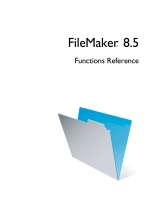 Filemaker Upgrade to FileMaker Pro 8.5 Retail 5-pack User manual
Filemaker Upgrade to FileMaker Pro 8.5 Retail 5-pack User manual
-
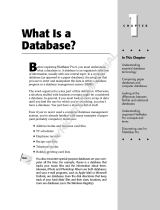 Wiley 978-0-470-08277-5 Datasheet
Wiley 978-0-470-08277-5 Datasheet
-
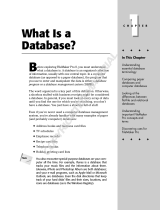 Wiley 978-0-471-77708-3 Datasheet
Wiley 978-0-471-77708-3 Datasheet
-
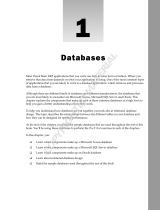 Wiley 978-0-7645-8894-5 Datasheet
Wiley 978-0-7645-8894-5 Datasheet
-
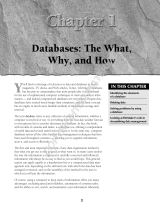 Wiley FileMaker Pro 10 Bible User manual
Wiley FileMaker Pro 10 Bible User manual
-
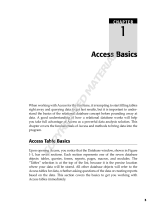 Wiley 978-0-7645-9978-1 Datasheet
Wiley 978-0-7645-9978-1 Datasheet
-
 Wiley 978-0-470-25703-6 Datasheet
Wiley 978-0-470-25703-6 Datasheet
-
HP 544530-001 User manual
-
Wiley 978-0-7645-7955-4 Datasheet
-
Microsoft C360 User manual







































































